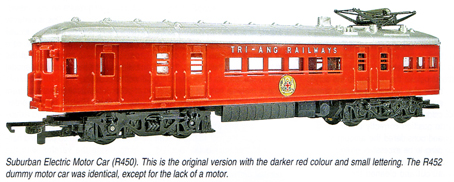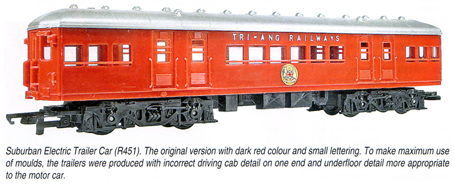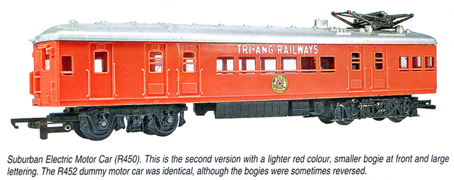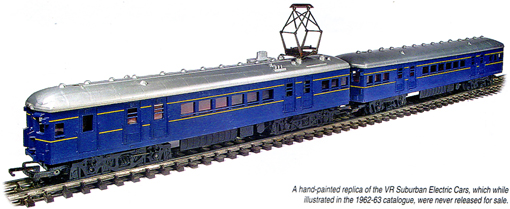Article
Retro Review - Tri-ang Australia NSWGR Suburban Electric (R450, R451 and R452) In OO/HO Scale
Author: Paul Rogers with assistance from Graeme Brown
Date: 31 May 2010
Related Model: N.S.W. Suburban Powered Motor Car (Aust)
* This article originally featured in the August 2008 edition of the Australian MODEL RAILWAY Magazine.
Tri-ang Australia NSWGR Suburban Electric (R450, R451 and R452) In OO/HO Scale. Produced by Tri-ang’s Australian subsidiary, Moldex, between 1960 and 1968. Current prices in text.
Good things come in red and yellow boxes… at least they did for Christmas 1960! At that time I was introduced to Tri-ang’s OO/HO range of model railways through the release of their Sydney suburban (Sputnik) electric cars. At the time, the full-sized vehicles had fairly recently entered service; indeed, the front cover of the Tri-ang 1960-61 Australian catalogue contained a ‘paste-over’ of the model ‘Sputniks’ placed over a photograph of the real train (Set S3) descending from the Sydney Harbour Bridge! (They were nicknamed ‘Sputnik’ as their release into traffic coincided with the launch of the first ‘Sputnik’ satellites by the Soviet Union.)
The Prototype
Under Contract 6/1954, Commonwealth Engineering of Granville supplied to the NSWGR 40 control motor cars and 40 non-control trailer cars for fast outer-suburban services within the Sydney Metropolitan Area. They were numbered C3701-C3740 and T4701-T4740 respectively.
Originally marshalled into eight car sets, these cars were the last single-deck, suburban electric trains built for the Sydney system, entering service between May 1958 and June 1960. They were also the first complete batch of power-door cars. In 1964-65, the single-deck cars in the power-door sets, were modified for working with the earlier single-deck manual door stock. The process caused the road numbers of the modified ‘Sputnik’ trailers to be altered to T4571-T4790. Cars C3737, C3738 and C3739 were converted to trailer cars N4679, N4680 and N4681. However incorrect N prefix was altered to the correct T prefix prior to their scrapping.
Control motor cars C3702 and C3708, together with Tulloch double-deck trailers T4801 and T4814, form the preserved W1 set of power-door cars. Surviving manual-door Sputnik trailers T4768 (ex T4718), T4471 (ex T4721) and T4790 (ex T4740) could, potentially, be restored to their earlier configuration.
Further information about the Sputnik cars can be found in First Stop Central (AETA, Sydney, April 1963) pp.102-03 and 120-21, Sydney’s Electric Trains (ARHS, Sydney, December 2007) pp.64-75 and The End of an Era – the Final Years of Sydney’s Single-Deck Electric Trains (Bow River Publishing, 2007) various pages. This latter is also a good pictorial source of the vehicles in their later years.
The Model
The Modex facilities in Melbourne were used between 1960 and 1968 to produce the ‘Sputnik’ cars in three distinct forms; viz:
Tri-ang Catalogue No.R450 – Powered Motor Car.
Tri-ang Catalogue No.R451 – Trailer Car.
Tri-ang Catalogue No.R452 – Dummy Motor Car.
sets; viz;
R3YA – Two car set containing R450 and R451 (with oval of track – 1960-61).
R4Y – Three car set containing R450, R451 and R452 (with no track – 1962-66).
R4YB – Three car set containing R450, R451 and R452 (with oval of track – 1968).
After 1966, the models were marketed as R450A, R451A and R452A respectively.
As built the Tri-ang cars were molded in a deeper red than the prototype colour. This is interesting, as the full-sized cars carried a lighter red paint scheme (variously described as Tuscan red or Venetian red) when built. Like all Tri-ang Transcontinental models of the period, they carried Tri-ang Railways lettering over the side windows. The body colour and lettering changed over the period the models were in production and there are three distinct versions. Early models are darker, with small Tri-ang Railways lettering. Later ones had a lighter pinkish red, with large lettering. The last models produced wore the lighter red with a return to the small lettering.
The NSW coat-of-arms had been used by various government agencies from the colonial days of the 1870s. Its application to new NSWGR electric stock, however, had to wait until 1958. The coat-of-arms carried the inscription Orta Recens Quam Pura Nites – which can be translated as ‘Newly Risen, How Brightly You Shine’. The coat-of-arms appeared on the Sputnik models with circular gold backing onto the red body colour, probably to make for better sighting. This feature of the models remained until their production ceased in the late 1960s. The prototype cars, however, originally carried the coat-of-arms placed directly onto the red body colour, and it was not until late 1968 that the real life Sputnik cars began to carry the coat-of-arms on a white oval backing placed onto the red bodywork. The logo ceased to be used with the advent of the NSW Public Transport Commission in 1972.
The ‘Sputnik’ cars were probably selected for production because they had all-welded steel bodies – therefore eliminating any external rivets – and, by nature of their design and control voltage, they were the only single deck electric trains in Sydney where matching motor/trailer car combinations could be guaranteed to run together. On the other hand, they had just been introduced when Richard Lines, from the factory in the UK, visited Moldex and may well have been chosen simply because they were ‘new’. Neither Moldex nor Richard Lines would have known much about Sydney suburban electrics.
We suspect that Tri-ang Sputnik cars were built to a nominal 1:83 scale, which Tri-ang used for their other TC models. They would have then been shortened, like the other Tri-ang models of the time, to run on the standard Tri-ang 13 1/2 inch radius curves. The length and width are the same as Tri-ang BR passenger stock of the time. So, it’s probably by sheer chance that the bodies were fairly close to HO scale in length (61ft 6in.) compared with the prototype (62t 8in.) and width (10ft 6in.) compared with the prototype (10ft 4in.).
The Tri-ang Sputnik cars would have been designed in 1958-59, which just predates Tri-ang’s move into models that were closer to scale dimensions. Apart from the beginners locos, the Sydney suburbans were probably the last semi-scale models that Tri-ang designed.
The roof appears to be well pro-portioned and well detailed. The roof mounted switchgear is a good representation of the prototype. The equipment doubled as a three-way switch enabling the Tri-ang cars to work off either the track or overhead wiring; the central position of this switch permitted the vehicle to be isolated from both electrical sources.
The over-scale height of the Tri-ang cars was noticeable. This was caused by the bogies used under the model vehicles. Early versions had powered bogies (for one end of the R450 cars) and ‘dummy’ powered bogies (for the other end of the R450 cars, and for both ends of the R451 cars). Both ends of the R451 trailers received a pair of ‘dummy’ power car bogies. So, the E and S type 8ft bogies found under the full size cars were represented by a single bogie of about 9ft wheelbase and with leaf springs for secondary suspension.
Later Tri-ang Sputnik cars seem, on occasions, to have been fitted with rather nondescript bogies. The first models had been fitted with ‘motor’ bogies on both motor cars and trailers to represent E and S type bogies. The Tri-ang bogies are about 10ft in HO scale and were based on the existing Tri-ang MkII power bogie used in the BR EMU (R156) and DMU (R157) models.
At some point in the early 1960s, Moldex started using a shorter bogie on the trailers and at the cab end of the motor cars, which seems to have been based on the M type7ft bogie. Why? Maybe to better resemble older suburban motor cars with their asymmetric bogies. Application of this bogie arrangement was random, and it’s not unusual to find Tri-ang Sputnik motor cars with two different bogies, with the shorter bogie under the pantograph, or trailers with one of each type of bogie.
The front of the motor cars (both R450 and R452) included correct features such as marker lights, whistle and target plates. On R451, the trailer, these features never existed, as there were never any driving trailers within the Sputnik series. (The bodies were made in a tool with interchangeable sides, so the trailer is effectively just a modified motor car and, therefore, the trailers have the motor car underframe detail as well). The layout of the model is based on the slightly earlier Tri-ang EMU and some parts are in fact interchangeable. This is typical of Tri-ang cost saving, making a recognizable, if inaccurate, model using the minimum of new parts. The pilot model shown on the cover, and inside, the 1960-61 Australian catalogue is fitted with an underframe from the SR EMU and bogies from the BR DMU.
The powered models were fitted with standard Tri-ang working pantographs and powered by a variant of the standard four-wheeled Tri-ang MkII power bogie. The performance of the models is what would be expected from this combination. The weight of the motor car is about 190g and the tractive effort is about 40g on Tri-ang track, which is reasonable even by modern standards, especially as only one bogie is driven. The power bogie is fitted with knurled wheels to help traction. As with any model with only one bogie powered, it will pull a longer train if the power bogie is at the rear, as this reduces weight transfer and tipping of the bogie. The trailers and dummy motor cars always had plain bearings, but a motor should easily pull a trailer and dummy motor on a typical Tri-ang layout of the period.
Like all Tri-ang mechanisms of the time, the power bogie is well designed, strongly built and easily maintained. Connection to the pantograph and roof switch is a bit problematic, and many surviving models have been rewired to improve track pick-up, or soldered which makes the roof difficult to remove for servicing. As with any Tri-ang model, any part could be easily obtained from any dealer in Australia.
With a transistor control, either a modern one, or the contemporary Moldex P5T, the model is quite controllable, starting at about 4V and with typical Tri-ang 13:1 gearing, reaching lift-off speed at around 12V. Scale speed is hard to calculate, given that the scale of the model is hard to calculate, bur speed at 12V would be well over the old scale ‘ton’ (160 km/h).
Tri-ang have always used their own track and wheel standards, with the Sydney suburbans having the usual very deep flanges and a narrow back-to-back measurement. Non driven wheels had sleeved axles and could move in and out on the axle to some extent. The models were introduced when Tri-ang were using the black Series 3 track and remained in production through Super 4 and System 6 track. Consequently, the Sputnik models will run on any Tri-ang or Hornby track, as well as older Peco code 100 Streamline.
The Tri-ang models of the Sputnik cars were only sold in Australia during the 1960s and were not as popular as the manufacturer had hoped, with probably only a few thousand being made. Due to relative rarity and demand from overseas Tri-ang collectors, prices remain high, even for repaints and damaged models. eBay prices have been known to go for four figures! Boxed sets are rare and are very expensive. Due to continued demand for the models, replica bodies and other parts have become available in the UK.
The ‘Blue’ Cars
Tri-ang’s 1962-63 Australian Catalogue announced Product Numbers R550, R551 and R552, which were repaints of the Sputnik cars into blue livery with yellow lining. Obviously intended to portray the Victorian Railways ‘Harris’ suburban cars, only a few samples were repainted into this blue colour scheme for display at a trade show. Accounts suggest that they were not well received and the models were never released commercially. Replicas repainted from standard models are known to exist and can be easily recognized, as ther are still red under the floor and inside the body.
Significance
Historically, these were the first mass produced HO models of a NSWGR prototype and were introduced when Tri-ang was moving from pure toys towards scale models. Unfortunately they did not sell well, with surviving records suggesting a total of less than 1000 of each model were made during the six years of production. These poor sales, in a period when model trains sales in general were falling, ensured that Moldex never introduced another Australian prototype model. The suburban cars appear to have sold mostly to adult modelers, as they are more common today that the limited production would suggest. Many of those found today have been repainted, or otherwise modified. The model’s long term effect on Australian prototype modeling was probably minimal, due to the prototype chosen. They are still the only available ready-to-run model of a ‘Sputnik’ set, and have long been left behind in terms of scale accuracy, but prices are very high due to their collectible nature. Prices can sometimes exceed $1500.00 (AU) for a set in good condition, though sales between $500.00 (AU) and $1500.00 (AU) are more common.
It is interesting to speculate what would have happened if Tri-ang had instead modeled a more popular NSW prototype, such as the C38, which was still in service at the time. In the event, no more Australian models were introduced until the late 1970s, by which time Tri-ang had changed its name to Hornby and their Australian market was under pressure from Lima.





















